Table of Contents
Introduction:
Leather, a timeless material synonymous with elegance and durability, whispers tales of craftsmanship and resilience. But beyond the polished surface lies a hidden world, a tapestry woven from animal hides, ancient techniques, and modern innovations. Join us on a journey beyond the hide, where we unveil the secrets of leather manufacturing. We’ll delve into the transformation of rawhide, explore the intricate art of tanning, and uncover the stories behind the brands you love. Prepare to be surprised, inspired, and maybe even a little bit awed by the magic that brings leather to life. So, grab your curiosity, buckle up, and get ready to discover the fascinating world that lies beyond the hide!
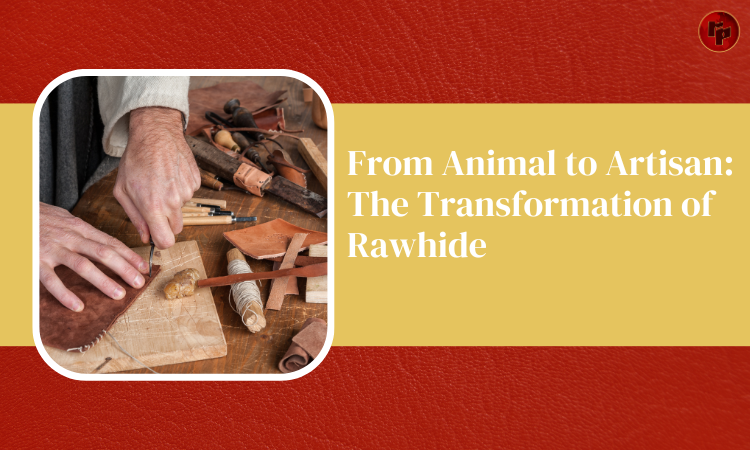
1. From Animal to Artisan: The Transformation of Rawhide
Step past the gleaming leather jackets and polished briefcases, and you’ll find the leather industry’s story beginning not in factories, but on farms. It starts with a rawhide, a natural canvas waiting for its transformation. This section of the journey is where science and art collide, where animal hides undergo a metamorphosis into the supple, durable material we know and love.
The first stage is salting and liming, a process that preserves the hide and removes hair and unwanted tissues. Then comes fleshing, where skilled artisans meticulously pare away any remaining flesh and fat, leaving a smooth, protein-rich foundation. Next, tanning – the heart of the transformation – takes center stage. Traditional methods like vegetable tanning use natural tannins from plants to achieve a beautiful patina and inherent antibacterial properties. Chrome tanning, on the other hand, is a faster process, offering greater flexibility and water resistance.
Once tanned, the hides undergo a series of mechanical processes like splitting, where they’re divided into layers depending on their thickness and desired usage. Finishing adds the final touches – dyeing for vibrant colors, waxes and oils for water resistance and a soft touch, and even embossing for intricate patterns.
Throughout this process, the artisan’s skill is paramount. From choosing the right tanning method to ensuring the leather retains its natural strength and beauty, every step requires deep knowledge and a keen eye. It’s a delicate dance between science and tradition, where natural materials are transformed into the versatile canvases that inspire leatherworkers, designers, and ultimately, you and me.
So, the next time you admire a beautifully crafted leather bag or run your fingers over a worn-in jacket, remember the journey it has taken. From humble animal to the hands of skilled artisans, each piece of leather whispers a story of transformation, a testament to the artistry and science that lies at the heart of the leather industry.
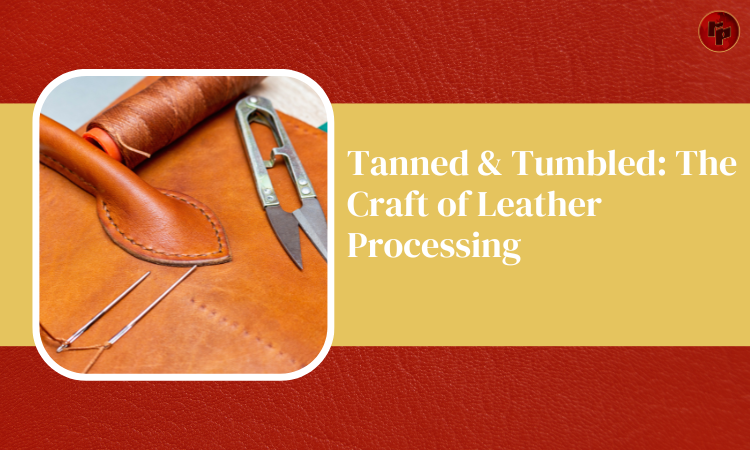
2. Tanned & Tumbled: The Craft of Leather Processing
The journey from rawhide to supple leather doesn’t end with tanning. It’s in the processing that the material truly acquires its character, its unique blend of strength and softness, its ability to tell a story through its surface. This stage, a dance between chemistry and craftsmanship, is where the raw potential of leather is unlocked, transforming it into the canvas for countless creations.
The first step is the drum. Large, rotating cylinders churn the tanned hides, tumbling them with a concoction of enzymes and oils. These break down the fibers, making the leather softer and more pliable. This process, called “bating,” is like a gentle massage, coaxing out the material’s natural suppleness.
Next comes the “setting out,” a crucial step where the leather is stretched and pulled to its desired shape and thickness. Skilled artisans use specialized tools and techniques to ensure the leather retains its integrity while acquiring the perfect form for its intended purpose. Imagine a sculptor molding clay, but instead of shapeless earth, their medium is the resilient, responsive hide.
Once shaped, the leather undergoes a final “drying and fatliquoring” process. Oils and waxes are applied, replenishing the natural fats lost during tanning and adding a desired level of water resistance and luster. This is where the leather truly comes to life, acquiring its distinctive scent and the soft, inviting touch that we associate with fine craftsmanship.
But the processing doesn’t end there. Some leathers undergo additional treatments like embossing, creating intricate patterns or textures. Others might be waxed or buffed to achieve a desired sheen or vintage feel. Each step, each technique, is a brushstroke in the leather’s story, adding depth and character to its surface.
Tanned & tumbled, leather emerges from this intricate process not just as a material, but as a canvas, a story waiting to be told. Whether it’s the smooth elegance of a briefcase, the rugged charm of a biker jacket, or the timeless beauty of a handcrafted wallet, each piece whispers of the artistry and dedication that transforms rawhide into a material that endures, inspires, and tells a story that transcends time.
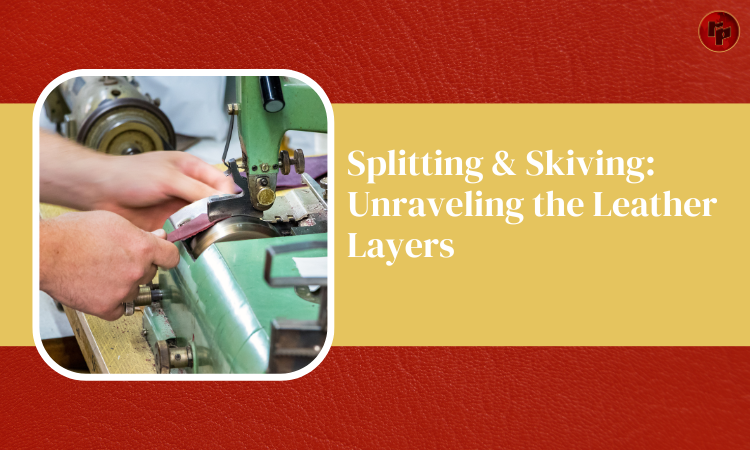
3. Splitting & Skiving: Unraveling the Leather Layers
Beneath the smooth surface of your favorite leather jacket lies a hidden world, a multi-layered story etched in the very fabric of the material. This is the realm of splitting and skiving, the delicate art of unraveling the secrets hidden within the thickness of a hide.
Imagine the hide as a layered cake, each layer with its own unique characteristics. The topmost layer, the full-grain, is the crème de la crème, boasting the strongest fibers, natural beauty, and durability. It’s the star of the show, often reserved for premium leather goods like wallets and belts.
But the story doesn’t end there. Skilled artisans, armed with specialized knives and machines, carefully peel away the next layer – the “corrected grain.” This layer, with its slightly less pristine surface, offers a balance of affordability and durability, making it ideal for wallets, bags, and upholstery.
Further down the cake, we find the split layer, a thinner, more uniform section with a fibrous texture. While not as luxurious as its top counterparts, it offers versatility and strength, finding its way into shoe soles, bookbinding, and even car interiors.
But the journey doesn’t stop at splitting. Skiving, a meticulous process akin to shaving, takes the layers even further, creating ultra-thin sheets of leather called “suede.” This soft, velvety material adds a touch of luxury to shoes, jackets, and even furniture, its unique texture whispering tales of comfort and sophistication.
Each layer, from the full-grain royalty to the humble suede, plays its own role in the leather story. Splitting and skiving are not just about maximizing efficiency; they are about unlocking the full potential of each hide, ensuring that no part goes to waste and every piece finds its perfect purpose.
So, the next time you admire the supple leather of your shoes or run your fingers over the smooth surface of a wallet, remember the hidden world within. Each layer whispers a story of craftsmanship, resourcefulness, and the ability to transform a humble hide into a multitude of beautiful and functional creations.
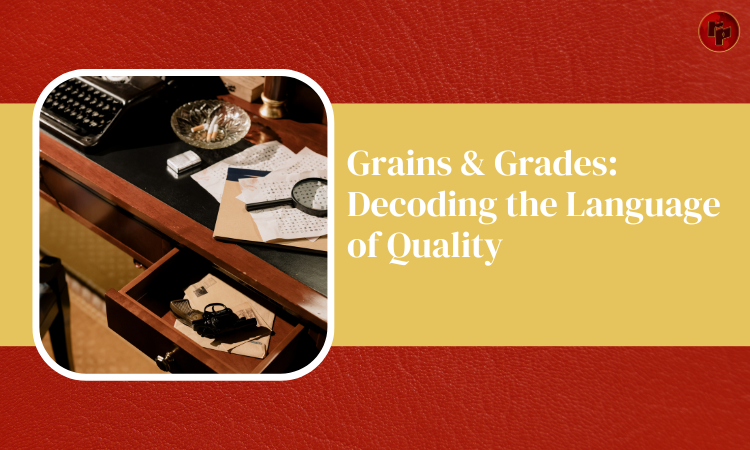
4. Grains & Grades: Decoding the Language of Quality
In the world of leather, the whispers of quality don’t just come from the touch or the scent – they’re also encoded in a language of grains and grades. For the uninitiated, navigating this language can feel like deciphering an ancient script. But fear not, leather enthusiasts, for this section is your Rosetta Stone, unraveling the secrets of grain types and grading systems, empowering you to make informed choices amidst the whispers of quality.
First, let’s talk grains. Full-grain, the undisputed king of the leather jungle, boasts every mark and imperfection, a testament to the animal’s life. Its natural scars and wrinkles tell a story of authenticity and durability, making it the ultimate choice for those who value raw beauty and timeless appeal.
Top-grain leather, the prince charming of the leather world, retains the natural grain pattern but undergoes a subtle surface correction, removing minor blemishes for a more uniform appearance. It offers a balance between natural beauty and practicality, making it a popular choice for bags, wallets, and furniture.
Corrected-grain leather, the workhorse of the industry, has its natural grain pattern altered or embossed to create a consistent texture. This makes it more affordable and stain-resistant, perfect for everyday items like shoes, belts, and car interiors.
Now, let’s decode the grades. Just like diamonds, leather is graded based on its flaws and imperfections. Grade A, the top of the heap, boasts minimal blemishes and consistent quality. Grade B might have minor marks or imperfections, while Grade C is reserved for leathers with more noticeable flaws, often used for industrial applications.
Understanding these grades empowers you to make informed choices. Don’t be fooled by a high price tag alone; a Grade A corrected-grain leather might not be as durable or authentic as a Grade B full-grain piece.
Ultimately, choosing the right grain and grade depends on your needs and preferences. Full-grain offers unparalleled character and longevity, while corrected-grain provides affordability and practicality. Remember, there’s no single “best” grain – it’s all about decoding the whispers and finding the leather that speaks to your own unique style and values.
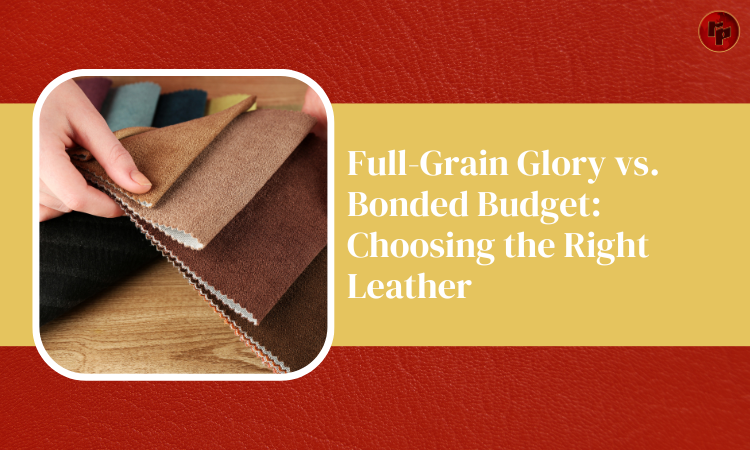
5. Full-Grain Glory vs. Bonded Budget: Choosing the Right Leather
Standing before a rack of leather jackets, a dilemma arises: full-grain’s luxurious whisper or bonded budget’s tempting song? Both hold their own allure, but understanding their differences is key to a harmonious purchase.
Full-Grain Glory: Imagine the untamed beauty of a mountain landscape, etched with time and experience. That’s full-grain leather, boasting every wrinkle and scar, a testament to the animal’s life. Its natural oils provide unmatched durability and patina, aging gracefully with each wear. It’s a statement piece, whispering tales of authenticity and timeless elegance. But be warned, its beauty comes with a price tag and susceptibility to scratches.
Bonded Budget: Picture a chameleon, adapting to blend in. Bonded leather is a composite, created by shredding and gluing lower-grade leather scraps together. It offers affordability and consistency, mimicking the look of full-grain at a fraction of the cost. It’s a reliable workhorse, perfect for everyday wear and tear. However, its durability and lifespan pale in comparison to full-grain, and its breathability might leave you feeling a little toasty.
So, how do you choose? It’s a dance between your values and needs.
Seek Full-Grain Glory if:
- You prioritize durability and timeless aesthetics.
- You appreciate natural imperfections and unique character.
- You’re willing to invest in a piece that will become an heirloom.
Embrace Bonded Budget if:
- You’re looking for affordability and practicality.
- You need a piece for everyday wear and tear.
- You value consistent texture and a more polished look.
Remember, there’s no right or wrong answer. Full-grain offers a story etched in every fold, while bonded leather sings a song of practicality. Listen to both whispers, understand your needs, and let the leather speak to your soul. After all, the perfect piece is the one that resonates with you, whispering a melody of quality that fits your lifestyle and budget like a glove.
6. From Chrome to Vegetable: Exploring Sustainable Tanning Techniques
Leather, a timeless material with a rich history, whispers not just of craftsmanship and elegance, but also of environmental impact. The tanning process, the heart of leather production, has traditionally relied on chemicals like chromium, raising concerns about sustainability and environmental damage. But amidst these whispers, a revolution is brewing, one where nature’s bounty takes center stage: vegetable tanning.
Chrome’s Efficiency, Nature’s Cost: Chrome tanning, the industry’s workhorse, boasts efficiency and speed. Chromium salts quickly bind to the hide’s proteins, resulting in durable and water-resistant leather. However, chromium is a toxic metal, posing risks to workers and the environment if not handled responsibly. Wastewater from chrome tanneries often carries harmful chromium residues, polluting waterways and ecosystems.
Vegetable’s Gentle Touch: Enter the stage of vegetable tanning, a slower, gentler dance with nature. Instead of harsh chemicals, this process relies on tannins, naturally occurring astringent compounds found in plants like bark, leaves, and fruit. These tannins slowly penetrate the hide, creating strong, supple leather with a unique, earthy aroma. Vegetable tanning is kinder to the environment, using renewable resources and generating less harmful waste.
The Whispers of Sustainability: While vegetable tanning might not match chrome’s speed, its whispers of sustainability resonate deeply. It offers a healthier work environment for tannery workers, reduces water pollution, and embraces renewable resources. Additionally, vegetable-tanned leather often develops a beautiful patina over time, aging gracefully and telling a story of its natural origins.
Making a Conscious Choice: As consumers, we have the power to guide the leather industry towards a more sustainable future. By choosing vegetable-tanned products, we support practices that respect the environment and prioritize the well-being of tannery workers. Look for certifications like “Vegetable Tanned” or “Eco-Leather” to ensure your purchase aligns with your values.
The journey from chrome to vegetable tanning is not just about a change in chemicals; it’s about a shift in mindset. It’s about recognizing the interconnectedness of our choices and the whispers of sustainability that guide us towards a more responsible future for the leather industry. So, the next time you admire a beautifully crafted leather piece, listen closely. Does it whisper of chrome’s efficiency or vegetable’s gentle touch? Let your conscious choices be the melody that shapes the future of leather, a future where beauty and sustainability dance hand-in-hand.

7. Beyond Bags & Belts: Unexpected Uses for Leather in Modern Life
Leather, that timeless whisper of elegance and durability, often conjures up images of sleek handbags and rugged belts. But this versatile material, with its inherent strength and natural beauty, has infiltrated the most unexpected corners of modern life, whispering its story into a symphony of surprising applications.
The Artistic Canvas: Forget the sterile white walls of galleries. Leather’s natural texture and unique grain patterns are now finding their way onto canvases, crafted into breathtaking wall hangings and sculptures. Artists are embracing its malleability, creating intricate textures and patterns that tell stories beyond the brushstroke.
The Culinary Companion: Imagine whipping up a gourmet meal with a leather apron protecting you from culinary splashes. Leather’s heat resistance and natural oils make it surprisingly adept at kitchen duty, appearing in aprons, knife rolls, and even coasters, adding a touch of rustic charm to your culinary adventures.
The Tech Whisperer: In a world dominated by plastic and metal, leather offers a touch of warmth and luxury to our digital companions. Phone cases, laptop sleeves, and even headphone covers crafted from leather add a tactile element to our tech, reminding us of the natural world even as we navigate the digital landscape.
The Eco-Warrior’s Ally: Leather, often associated with environmental concerns, can actually be a force for good. Vegetable-tanned leather, made from renewable resources and processed without harmful chemicals, is finding its way into sustainable packaging and even furniture, offering a durable and eco-conscious alternative to synthetic materials.
The Unexpected Muse: From musical instrument cases that resonate with the music they hold to book covers that whisper tales within their folds, leather is finding its way into the realm of the artistic and the creative. Its durability and natural beauty add a touch of timeless elegance to instruments, books, and even notebooks, becoming companions on journeys of artistic expression.
8. Tech Meets Tradition: Innovation in Leather Manufacturing
The leather industry, steeped in age-old traditions, might seem like an unlikely candidate for a tech revolution. But beneath the whispers of ancient craft, a fascinating dance is taking place – a waltz between time-honored techniques and cutting-edge technology, where innovation is reshaping the future of leather manufacturing.
From Tanned to Tailored with Lasers: Imagine laser beams dancing across a hide, not to burn, but to precisely cut intricate patterns or etch delicate designs. Laser cutting is revolutionizing leatherworking, offering accuracy, speed, and previously impossible design possibilities. Goodbye, manual die-cutting; hello, laser-sculpted masterpieces!
Sustainability Gets a Tech Boost: Traditional tanning processes, while effective, can be resource-intensive and environmentally impactful. Enter nanotechnology, with its promise of cleaner and more efficient methods. Nano-tanning techniques are emerging, reducing water consumption and chemical waste while still ensuring durability and quality.
Strength in Every Stitch: Forget the needles and threads of yesteryear. Robotic arms are now weaving intricate stitches with unparalleled precision and consistency. This automation not only boosts efficiency but also ensures consistent quality, making even the most complex designs a reality.
Beyond the Surface: Smart Leather Emerges: Imagine a leather jacket that heats up on a chilly day or a bag that wirelessly charges your phone. Smart leather is no longer a futuristic fantasy; it’s becoming a reality. Embedded sensors and conductive materials are weaving their way into leather, creating possibilities that were once unimaginable.
The Future is a Blend: This tech revolution isn’t about replacing tradition; it’s about enhancing it. The future of leather manufacturing lies in a harmonious blend of age-old craftsmanship and cutting-edge technology. Skilled artisans will continue to guide the process, their expertise complemented by the precision and efficiency of tech.
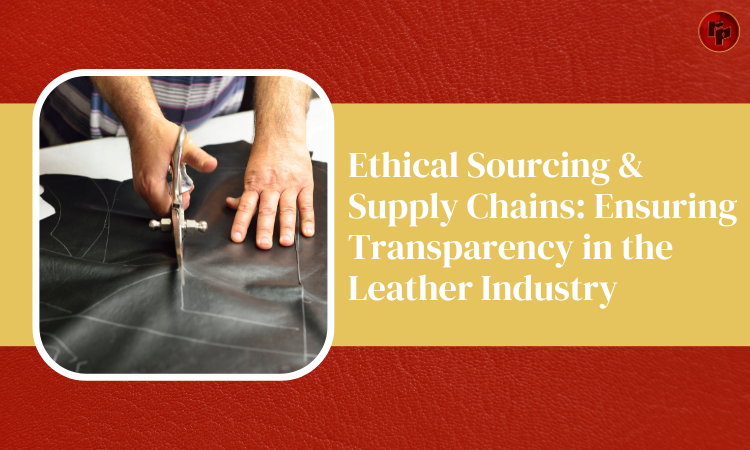
9. Ethical Sourcing & Supply Chains: Ensuring Transparency in the Leather Industry
The whispers of leather, once solely echoing tales of craftsmanship and luxury, now carry a new murmur – the whisper of ethics. Consumers are increasingly aware of the environmental and social impacts of their choices, and the leather industry, with its complex supply chains, is coming under scrutiny. But amidst this murmur, a melody of transparency is rising, one driven by ethical sourcing and responsible practices.
Lifting the Veil on Transparency: Traditionally, the leather supply chain has been shrouded in opacity. Hides often travel a long and convoluted journey, making it difficult to track their origins and ensure ethical practices at every step. This lack of transparency fuels concerns about animal welfare, environmental degradation, and worker exploitation.
Shining a Light on Sourcing: But the tide is turning. Ethical sourcing initiatives are emerging, empowering brands and consumers to make informed choices. Certifications like the Leather Working Group (LWG) and the Global Organic Textile Standard (GOTS) provide independent verification of ethical practices, ensuring responsible sourcing of hides from farms with good animal welfare standards.
Empowering the People: Transparency extends beyond animal welfare. The leather industry is also focusing on fair working conditions and ensuring the well-being of tannery workers. Initiatives like the Leather Impact Transparency Portal (LITP) offer a platform for sharing information and promoting better labor practices throughout the supply chain.
Traceability for Trust: Technology is playing a crucial role in this quest for transparency. Blockchain technology, for example, is being explored as a way to track hides from farm to finished product, providing consumers with verifiable information about the origin and ethical practices behind their leather purchases.
Whispers of Change: This journey towards ethical sourcing and transparent supply chains is not without its challenges. Building trust requires collaboration and commitment from all stakeholders – brands, manufacturers, and consumers alike. But the whispers of change are growing louder. Consumers are demanding transparency, and the industry is responding.
By choosing brands committed to ethical sourcing and responsible practices, we can amplify this melody of transparency. We can ensure that the whispers of leather not only tell a story of beauty and craftsmanship but also one of respect for animals, the environment, and the people who make this timeless material possible.
10. Caring for Your Leather Treasures: A Guide to Longevity
Leather, with its timeless elegance and natural beauty, deserves to be cherished. But like all good things, it needs a little love and attention to maintain its story for years to come. So, let’s embark on a journey of care, exploring simple tips to ensure your leather treasures endure, whispering tales of timeless elegance for generations.
Cleanse Gently: Forget harsh chemicals and abrasives. Leather thrives on gentle cleaning. For everyday dust and dirt, a soft, damp cloth is your best friend. For tougher stains, consult a professional leather cleaner or use a mild soap solution followed by thorough conditioning. Remember, water is leather’s enemy; avoid soaking or drenching.
Condition with Care: Think of conditioner as leather’s moisturizer. It nourishes the material, preventing dryness and cracks. Choose a conditioner suitable for the type of leather you have, and apply sparingly with a soft cloth. Remember, over-conditioning can lead to greasiness, so listen to your leather’s whispers and apply accordingly.
Store Wisely: Leather craves a cool, dry home. Avoid direct sunlight and heat, as they can dry and crack the material. Opt for a well-ventilated space, away from moisture sources like humidifiers. When not in use, store your leather treasures in breathable bags or dust covers, allowing them to breathe while keeping them safe from dust and scratches.
Embrace the Journey: Leather ages gracefully. The wear and tear, the subtle scuffs and patina, add character and tell its unique story. Don’t shy away from these natural markings; they are badges of honor, whispers of adventures shared and memories made.
Seek Professional Help: If your leather treasure suffers a major mishap, don’t despair! Seek professional help from a leather specialist. They can repair tears, restore scuffs, and rejuvenate even the most worn-out pieces. Remember, a little expert care can go a long way in extending the life of your leather treasures.
Conclusion
We’ve peeled back the hide, unveiling a world of alchemy and artistry. From humble animal to timeless masterpiece, leather’s story whispers of innovation, tradition, and a deep respect for nature’s bounty. Choose wisely, embrace its whispers, and let leather’s magic weave its way into your life, one crafted treasure at a time.
